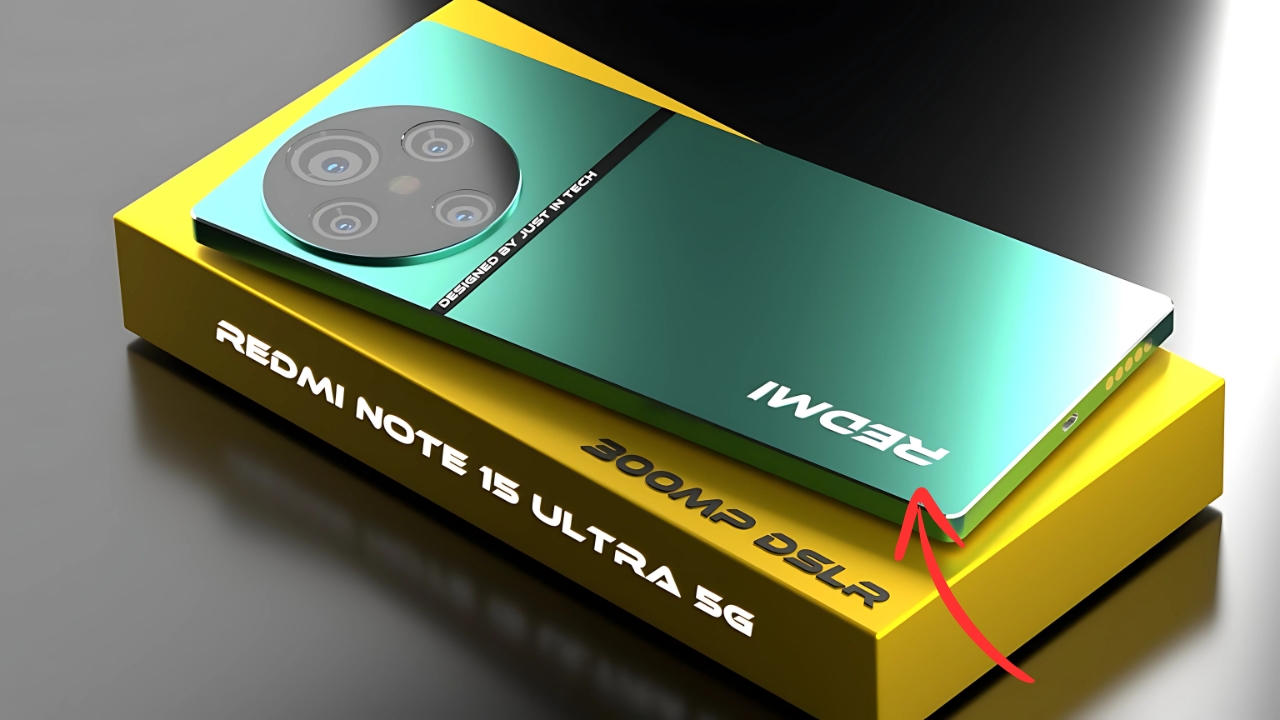Redmi Note 15 Ultra 5G: The smartphone industry continues to witness an accelerated convergence between premium and mid-range segments, with manufacturers incorporating increasingly sophisticated technologies at accessible price points.
The Redmi Note 15 Ultra 5G exemplifies this trend, representing Xiaomi’s most ambitious iteration of its popular Note series.
This device demonstrates how strategic hardware choices and software optimization can deliver exceptional value while maintaining the affordability that has defined the Redmi brand identity.
Redmi Note 15 Ultra 5G: Design and Build Quality
The Redmi Note 15 Ultra 5G embraces a design philosophy that balances contemporary aesthetics with practical durability.
The device features a precision-engineered aluminum frame sandwiched between Corning Gorilla Glass Victus protection on both front and rear surfaces—a significant upgrade from the plastic or glass-composite backs found in previous generations. This construction delivers substantial tactile quality while enhancing structural integrity.
Available in four distinctive colorways—Cosmic Black, Glacier Blue, Forest Green, and Sunrise Orange—each variant implements specialized optical engineering to create depth and visual interest.
The matte-textured glass rear panel effectively minimizes fingerprint retention while providing natural grip without requiring a case.
The rectangular camera module protrudes minimally, maintaining stable placement when used on flat surfaces.
With dimensions of approximately 162.3 × 75.7 × 8.1mm and weighing around 198 grams, the device strikes a reasonable balance between screen size and one-handed usability.
The addition of IP67 dust and water resistance represents a meaningful durability enhancement for the Note series, providing protection against environmental hazards without significantly impacting the manufacturing cost structure.
Display Technology
The front panel houses a 6.78-inch AMOLED display with 1.5K resolution (2712 × 1220 pixels), delivering approximately 446 PPI for excellent clarity across all content types.
This panel provides the deep blacks and vibrant color reproduction characteristic of OLED technology, enhanced by 12-bit color depth capable of rendering over 68 billion colors.
The 144Hz adaptive refresh rate ensures smooth scrolling and animation transitions, with dynamic adjustment between 1Hz and 144Hz based on content requirements to optimize battery life.
Peak brightness reaches an impressive 1,800 nits during HDR content playback, ensuring comfortable visibility even under direct sunlight. The display incorporates Dolby Vision and HDR10+ certification, enhancing dynamic range when consuming compatible content through streaming services.
The flat panel design maximizes usable screen space while minimizing accidental touch inputs along edges.
Protection comes via the aforementioned Gorilla Glass Victus, while the under-display fingerprint sensor utilizes the latest optical technology positioned within natural thumb reach, providing reliable biometric authentication without disrupting the display aesthetic.
Performance Architecture
Powering the device is MediaTek’s Dimensity 8300-Ultra processor, manufactured using TSMC’s 4nm process technology.
This chipset delivers exceptional computational efficiency through its heterogeneous core architecture, featuring four Cortex-A715 performance cores at 3.1GHz and four Cortex-A510 efficiency cores at 2.0GHz. The integrated Mali-G615 MC6 GPU handles graphical processing duties, delivering impressive gaming performance across demanding titles.
Memory configurations include options for 8GB, 12GB, or 16GB of LPDDR5X RAM paired with either 256GB or 512GB of UFS 4.0 storage. These high-speed standards ensure instantaneous app launching, rapid file transfers, and smooth multitasking even with demanding applications.
The absence of microSD expansion represents a deliberate choice to maintain structural integrity and simplified internal design.
The thermal management system implements a vapor chamber cooling solution spanning approximately 4,000mm², effectively dissipating heat during extended gaming sessions or computational tasks.
This advanced cooling solution maintains performance consistency while preventing throttling, addressing concerns regarding sustained performance under load.
Camera System
Photography capabilities center around a triple rear camera system co-engineered with imaging specialists. The primary sensor is Sony’s 50MP IMX906 with optical image stabilization, featuring 1/1.55″ sensor dimensions and f/1.6 aperture.
This hardware foundation enables exceptional light-gathering capability across various shooting conditions, particularly benefiting low-light photography.
Supporting the main camera is a 50MP telephoto module providing 3× optical zoom with OIS, extending to 30× through digital enhancement.
The 12MP ultrawide camera features a 123° field of view with macro capabilities, providing compositional flexibility without requiring a dedicated macro lens.
The 32MP front-facing camera handles selfie duties competently, with sophisticated portrait enhancements.
Computational photography features include advanced HDR processing, dedicated night mode capabilities, AI-enhanced scene recognition, and portrait lighting effects.
The Pro mode provides granular control over shooting parameters, while the “Movie Mode” offers cinema-oriented tools including focus peaking, zebra patterns, and LOG profile recording for post-processing flexibility.
Video capabilities include 8K recording at 24fps and 4K at up to 60fps, with excellent electronic and optical stabilization ensuring smooth footage even during movement. Slow-motion recording reaches 1080p at 960fps for creative expression.
Battery and Charging
The device houses a 5,500mAh silicon-carbon negative electrode battery that consistently delivers full-day usage even under demanding conditions.
This advanced battery chemistry increases energy density while maintaining safety standards, allowing for substantial capacity without excessive device thickness.
Charging capabilities include 120W HyperCharge wired technology, capable of replenishing from empty to 100% in approximately 25 minutes. Wireless charging supports 50W using the Qi standard, providing convenient alternatives without requiring proprietary accessories.
Reverse wireless charging at 10W accommodates accessories like earbuds and smartwatches.
Software Experience
The Redmi Note 15 Ultra 5G ships with HyperOS based on Android 14, representing Xiaomi’s evolved approach to user interface design. The software emphasizes fluidity and customization without excessive resource consumption, with animations optimized to take advantage of the high refresh rate display.
Xiaomi commits to three major Android version updates and four years of security patches, addressing previous criticisms regarding software longevity.
AI features include advanced image processing, smart resource management, and contextual recommendations that adapt to user behavior patterns.
Privacy protections have received particular attention, with granular permission controls and enhanced security for sensitive applications.
Connectivity and Additional Features
Connectivity options are comprehensive, featuring advanced 5G capability across multiple bands, Wi-Fi 6E, Bluetooth 5.3, and NFC for contactless payments.
The infrared blaster—a signature Xiaomi feature—enables universal remote control functionality for home appliances.
Dual stereo speakers with Dolby Atmos certification deliver impressive audio reproduction for media consumption.
Location services incorporate multi-band GPS for improved positional accuracy in challenging environments like urban canyons.
The haptic engine provides precise tactile feedback during typing and system navigation, contributing to the overall premium experience.
Redmi Note 15 Ultra 5G:
The Redmi Note 15 Ultra 5G represents Xiaomi’s most compelling demonstration yet of how flagship-grade technologies can be democratized without compromising the fundamental value proposition that has defined the Redmi brand.
By strategically incorporating premium components in critical areas—display, camera system, processor, and charging technology—while maintaining reasonable pricing, Xiaomi has created a device that challenges conventional categorization.
While the competitive landscape continues evolving rapidly, the Note 15 Ultra establishes a new reference point for mid-range devices, forcing competitors to reconsider their own feature allocations and pricing structures.
For consumers seeking maximum technological capability without premium pricing, this device offers compelling advantages that elevate it beyond adequate mid-range status into a genuine performance leader.









